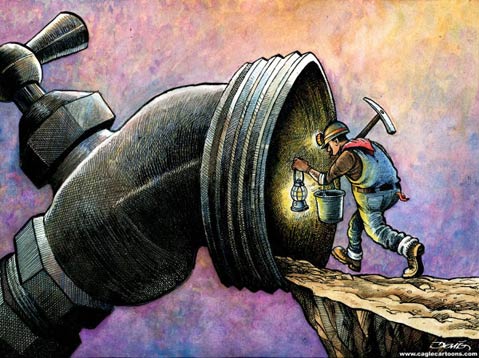The Truth About State Water
Santa Barbara's Supplemental Source Is Invaluable

California Water Impact Network’s (C-WIN) president, Carolee Krieger, recently provided her opinion about the State Water Project in Santa Barbara County and the proposed Twin Tunnels project currently being considered to move water around the fragile Sacramento-San Joaquin Delta. Unfortunately, Krieger’s opinion piece is short on truth and long on rhetoric.
Krieger likes to compare the construction cost estimates from the early 1990s for the Coastal Branch facilities of the State Water Project to the estimated total costs over the entire term of the contract (about 40 years). That’s similar to comparing the original purchase price of a house to the total cost of ownership over the 30-year mortgage, including interest, insurance, utilities, and so on.
Krieger gives $270 million as the original construction cost estimate of the Coastal Branch extension and $1.76 billion as actual costs. The truth is that the original construction cost estimate for the facilities actually constructed was $409 million. The actual costs of construction were $595 million. It’s true ALL costs over the entire term of the project are estimated at roughly $1.76 billion, but it is misleading to compare that number to the construction cost estimate.
Similarly, Krieger states the delivery reliability from the State Water Project to South Coast water agencies has averaged about 36 percent of the contracted allotments. Again, she uses an apples-to-oranges comparison. The fact is that over the past 10 years, the amount of water that was actually available to Central Coast Water Authority (CCWA) project participants averaged 77 percent of contracted allotments.
Each CCWA project participant determines the best mix of available water supply sources to meet its water demands. Most of the South Coast agencies primarily depend on their supplies from Lake Cachuma and sources other than the State Water Project. However, the importance of State Water Project deliveries as a supplemental water source cannot be overstated. The past year may very well prove to be the driest on record, and for the year 2014, the State of California Department of Water Resources (DWR) has estimated its initial allocation of water at only 5 percent of contracted water allotments. But because we are connected to the State Water Project and have the ability to store water and access other sources, we are able to provide around 39 percent of contracted water allotments. According to the Montecito Water District, the availability of State Water Project supplies is the only reason it is not requiring mandatory water rationing this year.
Krieger states C-WIN “adamantly opposes early State Water Project contract renewal,” claiming it will give license to issue revenue bonds for the proposed Twin Tunnels project. In fact, if the contracts are not extended now, State Water Project costs will increase. That’s because DWR can only finance large capital expenditures to the end of the current contract term, about 21 years. By extending the contract term, DWR will have the ability to finance projects over a typical 30-year period, thereby spreading the costs over more time. DWR and the State Water Project contractors believe this is vitally important regardless of whether the Bay Delta Conservation Plan (BDCP) moves forward because there are other, unrelated large capital projects that will require long-term financing.
C-WIN’s position on the proposed Twin Tunnels project is also interesting. Krieger writes that the BDCP will “deprive the Delta of fresh water, devastating both agriculture and fisheries.” Again, the facts tell a different story. If the draft plan is implemented, diversions of water from the Sacramento River are projected to fall within 10 percent of the average deliveries over the past 20 years. C-WIN wants you to believe you’ll be able to walk on dry ground across the Sacramento River after the tunnels are built. But under the BDCP, the allowable diversions at any particular time will be based on established limits to ensure the river and ecosystem are adequately and sufficiently maintained, all in line with the Legislature’s co-equal goals of water-supply reliability and environment enhancement.
C-WIN continues to claim that participation in the BDCP will bankrupt Santa Barbara County State Water Project participants. It’s the same message Krieger declared in the early 1990s, when the voters of many Santa Barbara agencies wisely voted to bring State Water Project supplies to the county as a supplemental water source. None of the cities or water districts that participated in the State Water Project has declared bankruptcy in the 22 years since the inception of the Central Coast Water Authority. In fact, the long-term debt issued by CCWA to construct the local facilities to bring State Water Project supplies into Santa Barbara County will be fully repaid in seven years. That means the annual State Water Project costs from CCWA will eventually decrease by about $11.5 million a year. Preliminary estimates of construction costs of the BDCP allocated to Santa Barbara County are somewhere around $100 million, with estimated annual costs of roughly $9 million for all debt service including interest, power, and operations and maintenance.
Ironically, C-WIN and Krieger bemoan the fact that the State Water Project is not reliable, but they are opposed to a comprehensive proposal to both shore up the reliability of the system and contribute to the recovery of threatened and endangered species in the Sacramento-San Joaquin Delta.
The residents of Santa Barbara County have invested hundreds of millions of dollars to bring State Water Project supplies into the county for dry times such as this. Without significant rainfall in calendar year 2014, water from the State Water Project may indeed be a resource that ensures we won’t have to paint our lawns and put buckets in our showers.
Ray Stokes is executive director of the Central Coast Water Authority, which, since 1991, has constructed, managed, and operated facilities for distribution and treatment of State Water for project participants in Santa Barbara and San Luis Obispo counties. More information at ccwa.com.



